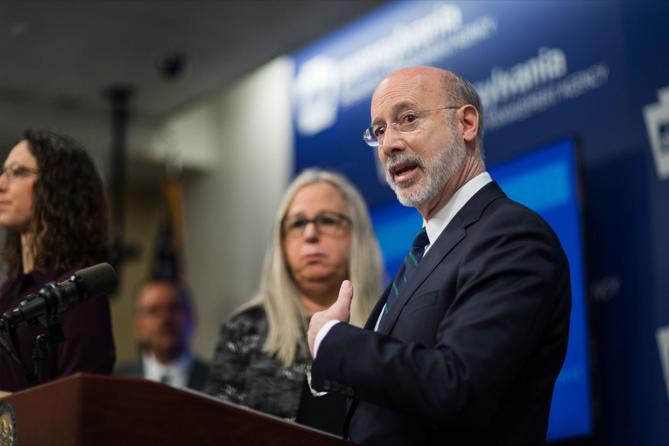Spotlight PA is an independent, nonpartisan newsroom powered by The Philadelphia Inquirer in partnership with the Pittsburgh Post-Gazette and PennLive/The Patriot-News. Sign up for our free weekly newsletter.
State officials will allow 12 more counties across Pennsylvania to ease coronavirus restrictions, as Gov. Tom Wolf urged areas still under strict lockdown orders to stay the course.
The counties announced Friday, primarily in south-central and northeast Pennsylvania, will be allowed to enter the “yellow” phase of the state’s tiered reopening plan on May 22. They will join 37 north-central and western counties where the state has allowed residents to freely leave their homes while taking certain safety precautions and some businesses to resume in-person operations.
“Across the state, the rate of infection has been declining over the past 14 days,” Health Secretary Rachel Levine said Friday. “But we are still seeing pockets of outbreaks that are of concern. The good news is that the current load of COVID-19 has peaked in Pennsylvania. However, some areas of the state have only just begun to experience meaningful declines."
The counties announced Friday are Adams, Beaver, Carbon, Columbia, Cumberland, Juniata, Mifflin, Perry, Susquehanna, Wyoming, Wayne, and York.
Several counties on Friday’s list had lobbied Wolf to reopen, while officials from at least two had publicly threatened to restart their local economies without the state’s approval. That includes Beaver County, where a devastating coronavirus outbreak in one nursing home is responsible for nearly all of the area’s deaths.
Levine said the county met “all criteria to go from red to yellow," and “has had significantly decreasing case counts over the last two weeks." Wolf reiterated that the data are driving the state’s decisions.
“Politics has nothing to do with this," he said.
Not included in Friday’s announcement are Lancaster and Lebanon Counties, where local officials have vowed to at least partially reopen today, without Wolf’s blessing.
In March, Wolf implemented broad stay-at-home and business closure orders to prevent hospitals from becoming overwhelmed by coronavirus patients. As business owners and some lawmakers began to question the strict lockdown, Wolf’s administration on May 1 announced that 24 of the state’s 67 counties could reopen.
That number grew to 49 counties on Friday, representing roughly 40% of Pennsylvania’s population.
The administration has set certain benchmarks for reopening, including having enough testing and contact tracing to prevent future outbreaks. Another target is seeing fewer than 50 new confirmed cases per 100,000 people over two weeks. That is a metric that several counties, including those in the hard-hit southeast, have yet to meet.
Wolf said the state will release biweekly reports from Carnegie Melon University, which has developed “risk-based decision support tools” to help officials make reopening decisions.
These reports will “help Pennsylvanians to understand the risk factors where they live," Wolf said. “The metrics in this report help us weigh quantifiable risk factors.”
He added that the state also considers “subjective information from our epidemiologists and health professionals” when deciding which counties can move from the red to yellow phase.
In the yellow phase of Wolf’s reopening plan, daycare centers can reopen and retail stores can welcome in-person visits, though curbside pickup and delivery remain preferable, and certain safety precautions must be taken. Gyms, hair salons, and movie theaters must stay shuttered.
Companies must provide teleworking options to employees if their work can be done remotely. If they don’t have that ability, they can resume in-person operations with certain safety precautions.
“Now if you live in one of the 18 counties that remains in the red zone, you may feel disappointed or frustrated right now,” Wolf said. “It’s easy to look outside and see a beautiful spring day and think, ‘hey there’s no danger.’ But the danger’s there. It’s real. And we need to take that seriously.”
100% ESSENTIAL: Spotlight PA relies on funding from foundations and readers like you who are committed to accountability journalism that gets results. If you value this reporting, please give a gift today at spotlightpa.org/donate.

